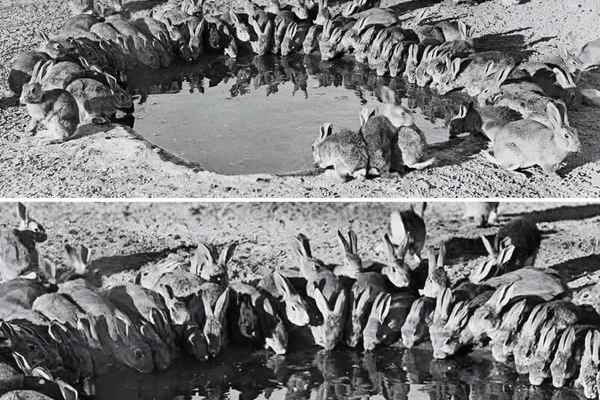
However, this seemingly harmless act unleashed one of the most devastating ecological disasters in history.
The rabbits, facing no natural predators and enjoying favorable breeding conditions, rapidly multiplied.
By 1920, their population had ballooned to an estimated 10 billion, spreading across Australia like wildfire.
This uncontrolled explosion led to catastrophic environmental damage. The rabbits destroyed crops, eroded soil, and decimated native vegetation, pushing some local species to the brink of extinction.
Efforts to control their population, including fences and biological methods, often proved futile.
The rabbit plague remains a stark reminder of how introducing non-native species can disrupt ecosystems and cause long-term harm.
This fascinating black-and-white image captures an unusual and captivating moment in nature: a large group of rabbits gathered around a small watering hole in the middle of a dry, open landscape. Labeled “New Africa,” the photo instantly draws the viewer into a surreal scene where the barren ground contrasts starkly with the abundant life crowding around the vital source of water. It is both charming and thought-provoking, reminding us of the beauty of wildlife and the fundamental role of water in sustaining life.
At first glance, it might seem like a digitally altered image or a whimsical creation. After all, it’s uncommon to see so many rabbits in one place, let alone drinking side-by-side in complete harmony. But whether staged or naturally occurring, the photo conveys powerful themes of survival, unity, and nature’s delicate balance. Every rabbit in the image is positioned in such a way that it creates a near-perfect circle around the water, suggesting both instinct and unspoken coordination in their behavior.
This scene likely represents the desperation and dependency that animals in arid environments have on scarce water sources. In places where rainfall is rare and vegetation limited, waterholes become not just a necessity but a central hub for all forms of life. In that sense, the image speaks to the ongoing environmental challenges facing not only rabbits but wildlife populations around the globe: habitat loss, climate change, and human development. In many parts of Africa and beyond, animals—large and small—gather at watering holes, often competing, coexisting, or risking predation just to quench their thirst.
Symbolically, the image could be viewed as a metaphor for human behavior as well. The rabbits, gathered in peaceful unity around a shared resource, remind us of the need for cooperation in times of scarcity. It also emphasizes how a single natural resource can bring together individuals from all walks—or hops—of life. In today’s world, where resources like clean water and arable land are increasingly under threat, this photo encourages reflection on how we use, manage, and value the Earth’s limited assets.
The photo also carries a haunting beauty. The absence of color adds a layer of timelessness and mystery, stripping the scene down to its essentials: life and survival. The reflections in the water add a sense of depth and clarity, showing not only the rabbits’ images but mirroring the sky above—linking earth and heaven in one tranquil moment. There’s something cinematic about the entire composition, as if it’s a still frame from a nature documentary or an art film.
In conclusion, this image of rabbits gathered around a watering hole in “New Africa” is more than just an eye-catching photograph. It’s a testament to the interconnectedness of life, the resilience of wildlife, and the ever-present importance of nature’s most basic resources. Whether viewed as a biological curiosity, a poetic metaphor, or an environmental statement, the photo invites us to pause, appreciate, and protect the natural world and its wonders.


